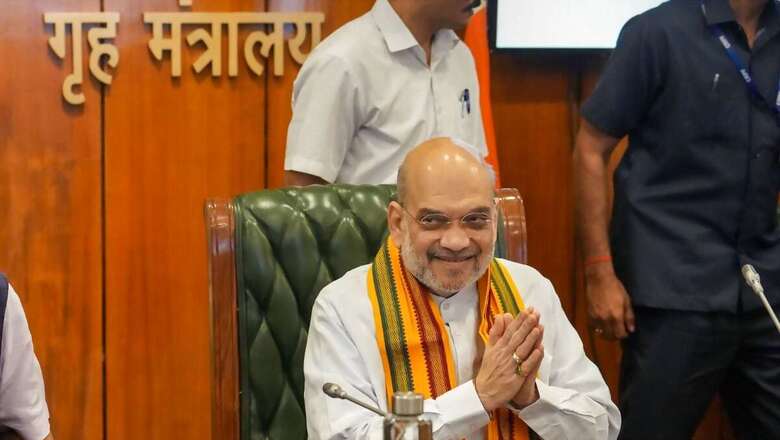
views
A data comparison of the crackdown on insurgency or extremism in the seven northeastern states in the UPA years versus the NDA years throws up some interesting points. The pattern shows that the pace has gone up during the NDA regime, with an intensified campaign during home minister Amit Shah’s tenure.
Shah assumed charge of the ministry of home affairs following the BJP-led NDA’s victory in the May 2019 Lok Sabha elections. Data comparison before his term and after his appointment shows 60 percent drop in extremist incidents, as well as 77 percent drop in fatalities of security forces personnel and civilians.

Peace talks expedited, security tightened
From 2004 to 2013, the seven northeastern states – Arunachal Pradesh, Assam, Manipur, Meghalaya, Mizoram, Nagaland and Tripura – witnessed 11,438 extremist incidents that killed 507 security forces personnel and 2,712 civilians. The anarchy prevailing in these states witnessed 2,808 people kidnapped in this time period as well. In counter-insurgency operations, a total of 3,629 extremists were killed, 18,779 arrested and 9,196 surrendered with 3,515 arms. The number of arms recovered were 10,032.
From 2014 to 2022, however, the numbers witnessed a great downward slide. It was the result of a strategy drawn out keeping in mind geographical location and ethnic tension in the northeastern states. To resolve ethnic tensions, the central government expedited ongoing peace talks between different ethnic groups; and simultaneously augmented internal and external security measures in these border states.
Measures introduced to tackle infiltration from Bangladesh
Assam, Meghalaya and Tripura share semi-porous borders with Bangladesh while Arunachal Pradesh, Nagaland and Manipur with Myanmar. Mizoram shares a semi-porous border with both Bangladesh and Myanmar.

Reduced numbers of extremist incidents over the years during the NDA regime reflect a greater crackdown by the security forces internally as well as on border areas with China, Myanmar, and Bangladesh. Extremists not only got internal support and sympathisers, but also had support networks and training centres across the borders in Myanmar and Bangladesh. China, too, was suspected to have a hand in training camps for northeast extremists around the 1960s, said intelligence sources.
That mechanism still continues, but in a different form. There are no more training camps, but China still gives arms and shelter to extremists of northeast India. ULFA chief Paresh Baruah and other northeast extremists on the run are suspected to be hiding in China.
Another massive issue was infiltration from Bangladesh, largely into Assam. Many extremists might also have entered the country disguised as civilians. Further, these illegal civilians were also suspected to have created shelter options and support networks for extremists by working as their overground workers (OGWs).
The NDA government looks to have effectively dealt on these fronts. Diplomacy with neighbouring countries and troop deployment at borders restricted the outside support extremists were getting. The counter measures also involved a counterinsurgency or “surgical operation” on training camps of Naga insurgents in 2015. A total of 70 commandos of the special forces attacked and destroyed the training camps run by NSCN(K) and KYKL, killing 38 insurgents.
Restricting outside support means half the battle won. The rest was to conduct an internal crackdown, to find hideouts, support networks, and funding mechanisms to eliminate leftover strength.
Important trend: Surrender by extremists
Between 2014 and 2022, extremist incidents significantly dropped to 3,238. It was one of the most visible examples of improvement on the security front. Reduced support meant reduced numbers of extremists visible in the northeastern states, which means reduced number of extremist incidents. In this time, 587 extremists were killed, 9,666 arrested and 7,342 surrendered; 4,787 arms recovered and 1,755 were surrendered.
The direct reflection that the northeast was now a much more secured place can be seen in the massive drop in casualty figures of civilians and security forces personnel.

During the UPA period, the seven northeastern states saw on an average of 1,144 terror incidents a year. That came down to 360 during the NDA years with a drop of 71.77 percent. The fatality figures of security forces personnel and civilians were down by 74.75 percent and 84.51 percent, respectively.
The more important data trend to see is related to the surrender of extremists: it went up by 700 percent. This conveys that extremist networks in the northeast have little or no support and most have no option but to surrender. Data from 2022 clearly spells it out – two security forces personnel and seven civilians were killed while over 550 extremists were arrested and 2,000 surrendered.




















Comments
0 comment